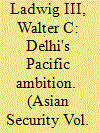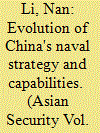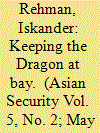|
|
|
Sort Order |
|
|
|
Items / Page
|
|
|
|
|
|
|
| Srl | Item |
| 1 |
ID:
089066


|
|
|
|
|
| Publication |
2009.
|
| Summary/Abstract |
For almost four decades, China has disputed Japan's sovereignty of several small rocky islands in the East China Sea. Despite a June 2008 joint gas development agreement, China continues to claim sovereignty and the dispute is nowhere close to being resolved. This study proposes that China benefits from the endurance of the dispute because it can use territorial dispute threats to compel Japan to change its behavior or policy on other disputed issues. The results show that China gained concessions on other issues by using the territorial dispute as bargaining leverage in most of the 26 threats made between 1978 and 2008.
|
|
|
|
|
|
|
|
|
|
|
|
|
|
|
|
| 2 |
ID:
089062


|
|
|
|
|
| Publication |
2009.
|
| Summary/Abstract |
While India may not traditionally be considered to be a significant actor in the Asia-Pacific region, over the past 18 years, New Delhi has undertaken a concerted effort to direct its foreign, economic, and military policies eastward. What began as economic cooperation with the nations of Southeast Asia has expanded into full-spectrum engagement with the major powers of East Asia. This article explores India's emergence in the Asia-Pacific, concluding that, while in the near term India's presence and influence will be felt most strongly in Southeast Asia, a steadily expanding economy, paired with a growing partnership with key regional actors and an increasingly capable Navy, positions the South Asian giant to have an impact on the emerging security architecture of the region.
|
|
|
|
|
|
|
|
|
|
|
|
|
|
|
|
| 3 |
ID:
089064


|
|
|
|
|
| Publication |
2009.
|
| Summary/Abstract |
This study first shows that China's naval strategy has undergone two major changes: from "near-coast defense" prior to the mid-1980s to "near-seas active defense" after the mid-1980s, and then to the advancement of a "far-seas operations" strategy. Related to the evolution of naval strategy is the change in naval capabilities: from limited capabilities for coastal defense to more expansive capabilities to operate more effectively in China's near seas by the late 2000s. The new strategy of "far-seas operations" endorsed since the mid-2000s may have major implications for the future development of China's naval capabilities. Second, this study argues that changes in naval strategy and capabilities can be accounted for by a combination of major variables, including the role of naval leadership and personal experience, endorsement of civilian leadership, changing perception of external security environment, availability of funding and technologies, and institutionalization of naval research. Also, while a major change in naval capabilities may be related to a change in naval strategy, it may also be driven by other highly contingent or idiosyncratic reasons.
|
|
|
|
|
|
|
|
|
|
|
|
|
|
|
|
| 4 |
ID:
089063


|
|
|
|
|
| Publication |
2009.
|
| Summary/Abstract |
Ever since their emergence as modern states in the middle of the twentieth century, relations between India and China have been exceedingly complex in nature and, for the most part, fraught with tension. This article reviews aspects of the Sino-Indian relationship over the past decade from a realist perspective, showing that despite surface improvements, bilateral ties are still marred by strong feelings of mistrust. It is argued that China has engaged in a policy of containment of India, challenging its regional pre-eminence in South Asia and stymieing its neighbor's emergence as a major world power. A careful study of India's newly assertive foreign policy, both in Asia and beyond, reveals that New Delhi has chosen to back its policy of engagement of Beijing with a form of counter-containment.
|
|
|
|
|
|
|
|
|
|
|
|
|
|
|
|
|
|
|
|
|